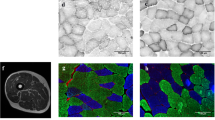Summary
Muscle ultrastructure of a group of subjects possessing extreme hypertrophy was compared with that of a control group which had undergone 6 months of heavy resistance training. Two needle biopsies were taken from triceps brachii of two international calibre powerlifters and five elite bodybuilders. In addition, samples were taken from five healthy volunteers before and after 6 months of training of the elbow extensors. One biopsy was prepared for electron microscopy and analyzed stereologically, and the other was stained for myosin ATPase activity and photographed under the light microscope. Despite large differences in elbow extension strength and arm girth there was no significant difference in fibre areas or percentages of fibre types between the elite group and the trained controls. This suggests that the elite group possessed a greater total number of muscle fibres than the controls did. Mitochondrial volume density of the elite group was similar to that of the control group following training but significantly less (p<0.05) than the pretraining control measurements. Myofibrillar volume density was significantly lower and cytoplasmic volume density significantly higher in the elite group than in the trained controls. There was a considerably higher incidence of structural abnormalities including central nuclei and atrophied fibres in the elite group than in the control group, which might possibly have been associated with the use of anabolic steroids by the elite group.
Similar content being viewed by others
References
Brooke MH (1973) The pathologic interpretation of muscle histochemistry. In: Pearson CM, Mostofi FK (eds) The strialed muscle. Williams and Wilkins, Baltimore, pp 86–122
Dorman JD (1973) The histopathology of neurogenic muscular atrophy. In: Pearson CM, Mostofi FK (eds) The strialed muscle. Williams and Wilkins, Baltimore, pp 249–262
Dubowitz V, Brooke MH (1973) Muscle biopsy: a modern approach, chap 11. Saunders, London Philadelphia Toronto
Edström L, Torlegård K (1969) Area estimation of transversely sectioned muscle fibre. Z Wiss Mikrosk 60: 166–179
Gonyea W, Ericson GC, Bonde-Petersen F (1977) Skeletal muscle fibre splitting induced by weight-lifting exercise in cats. Acta Physiol Scand 99: 105–109
Gonyea W (1980) Role of exercise in inducing increases in skeletal muscle fiber number. J Appl Physiol 48: 421–426
Jablecki CK, Hauser JE, Kaufman S (1973) Autoradiographic localization of new RNA synthesis in hypertrophying skeletal muscle. J Cell Biol 57: 743–759
Kovanen V, Suominen H, Heikkinen E (1980) Connective tissue of “fast” and “slow” skeletal muscle in rats — effects of endurance training. Acta Physiol Scand 108: 173–180
MacDougall JD, Ward GR, Sale DG, Sutton JR (1977) Biochemical adaptation of human skeletal muscle to heavy resistance training and immobilization. J Appl Physiol 43: 700–703
MacDougall JD, Sale DG, Moroz JR, Elder GCB, Sutton JR, Howald H (1979) Mitochondrial volume density in human skeletal muscle following heavy resistance training. Med Sci Sports 11: 164–167
MacDougall JD, Elder GCB, Sale DG, Moroz JR, Sutton JR (1980) Effects of strength training and immobilization on human muscle fibres. Eur J Appl Physiol 43: 25–34
Padykula HA, Herman E (1955) The specificity of the histochemical method of adenosine triphosphatase. J Histochem Cytochem 3: 170–195
Pipes TV (1979) Physiological characteristics of elite body builders. The Physician and Sportsmedicine 7: 116–122
Thorstensson A (1976) Muscle strength, fibre types, and enzyme activities in man. Acta Physiol Scand [Suppl] 443: 1–44
Turto H, Lindy S, Halme J (1974) Protocollagen proline hydroxylase activity in work-induced hypertrophy of rat muscle. Am J Physiol 226: 63–65
Weibel ER (1972) A Stereological method for estimating volume and surface of sarcoplasmic reticulum. J Microsc 95: 229–242
Author information
Authors and Affiliations
Additional information
This study was funded by the Muscular Dystrophy Association of Canada
Rights and permissions
About this article
Cite this article
MacDougall, J.D., Sale, D.G., Elder, G.C.B. et al. Muscle ultrastructural characteristics of elite powerlifters and bodybuilders. Europ. J. Appl. Physiol. 48, 117–126 (1982). https://doi.org/10.1007/BF00421171
Accepted:
Issue Date:
DOI: https://doi.org/10.1007/BF00421171




